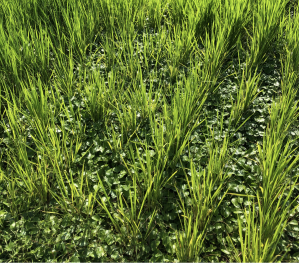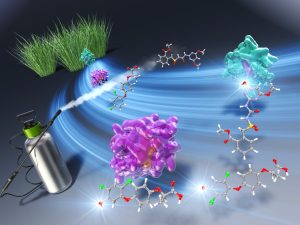Research - Iwakami Lab
The history of crop cultivation is also the history of the battle between humans and weeds.
Humans have developed new technologies one after another in an effort to eliminate weeds from agricultural land. Weeds, on the other hand, have “evolved” traits to get around such attacks. Mimicry to crops, morphology that withstands weeding pressure, germination characteristics that shift the timing of germination to prevent rounding up, and so on.
Herbicides are the most powerful technology ever created by the human side. By cleverly exploiting small genetic differences between crops and weeds, they are designed to be lethal only to weeds. However, weeds have evolved resistance to this extremely powerful stress in the same way, or rather in a shorter period of time, than they had before.
I hope to decipher the battle between humans and weeds that has been waged in agricultural fields through the analysis of crop and weed genomes and genes.
Metabolism-based Super Weeds
Among herbicide-resistant weeds, those that have evolved resistance through enhanced herbicide detoxification (metabolism-based resistance) pose a particularly serious problem. These metabolically resistant weeds often exhibit resistance not only to herbicides they have been exposed to, but also to newly introduced herbicides with entirely different chemical structures and modes of action, making them especially difficult to control.
We have been studying the resistance mechanisms of Echinochloa phyllopogon, a grass weed found in California rice fields, where resistance was first reported in the late 1990s. This population showed resistance not only to herbicides used at the time, but also to newly developed herbicides with distinct structures and modes of action introduced later.
While cytochrome P450 enzymes were suspected to be involved in the resistance, the large number of P450 genes in plants made it difficult to identify the causal genes, especially in weed species lacking comprehensive genomic resources. Although several weed species have been reported to exhibit similar metabolic resistance, the molecular basis remained unclear in most cases.
Against this backdrop, we succeeded in identifying cytochrome P450 genes involved in resistance in E. phyllopogon (Iwakami et al. 2014; Iwakami et al. 2019). Two P450 genes were found to be overexpressed in resistant plants, and they were shown to metabolize a remarkably wide range of herbicides. Subsequent studies revealed that the E. phyllopogon genome also contains several other genes capable of herbicide detoxification (Guo et al. 2019; Dimaano et al. 2020).
Currently, we are working on decoding the E. phyllopogon genome (Sato et al. 2023) and investigating the detailed mechanisms underlying its multiple-herbicide resistance (Suda et al. 2023), including studies on newly emerging resistant populations in Japan.
Related Works
- Iwakami et al. 2014 Plant Physiology
- Iwakami et al. 2019 New Phytologist
- Guo et al. 2019 Plant Science
- Dimaano et al. 2020 Plant Molecular Biology
- Suda et al. 2023 Plant Physiology
- Sato et al. 2023 DNA Research
Parallel evolution in Monochoria vaginalis
Parallel evolution refers to the phenomenon in which closely related populations independently evolve the same or similar traits. Herbicide resistance is a representative example of this, as similar resistance traits against the same herbicides have repeatedly evolved across weed species and geographic regions. This suggests that the number of genes available for resistance evolution is extremely limited — that is, weeds may have only a narrow range of “evolutionary options” to address herbicide stress. Such insights have been applied to the development of diagnostic tools for resistance genes and new herbicides effective against resistant weeds.
We have been investigating the molecular basis of parallel evolution in acetolactate synthase (ALS) inhibitor resistance using the rice paddy weed Monochoria vaginalis. While most weed species possess only a single ALS gene—the target of ALS-inhibiting herbicides—M. vaginalis carries at least four copies (ALS1–ALS4), and we have additionally identified a fifth copy, ALS5 (Iwakami et al. 2020).
We analyzed >60 resistant M. vaginalis populations collected from rice fields across Japan and found resistance-conferring mutations only in ALS1 or ALS3. No such mutations were detected in ALS2, ALS4, or ALS5. Given that mutations arise randomly, resistance could in theory evolve via any of the gene copies. However, in reality, mutations were strongly biased toward specific copies.
To understand this bias, we examined the function and expression levels of each ALS gene. While the encoded proteins showed no major functional differences, we found that the expression levels of ALS2, ALS4, and ALS5 were extremely low. This suggests that even if mutations occur, they may not confer resistance unless the gene is expressed at a sufficient level—highlighting the possibility that gene expression regulation can constrain which genes are available for adaptive evolution (Tanigaki et al. 2021).
We are currently working on functional characterization of these resistance mutations and further investigating the regulatory mechanisms underlying their expression.
Related Works
- Iwakami et al. 2020 Pesticide Biochemistry and Physiology
- Tanigaki et al. 2021 New Phytologist プレスリリース
Crops are tolerant to herbicides!

While weed resistance to herbicides poses a significant problem, there are also numerous agricultural fields where weed control has been successfully achieved through herbicide application. The key to effective weed control with herbicides lies in their selectivity. Many herbicides used in agricultural fields are designed to kill weeds while having minimal impact on crop growth. Even though crops and weeds may belong to the same plant species, herbicides exploit the differences between crops and weeds to achieve selectivity. However, in many cases, the underlying differences remain poorly understood.
Our research aims to unravel the genetic-level differences between crops and weeds that are exploited by selective herbicides. By deciphering these distinctions, we strive to enhance our understanding of the selectivity mechanisms employed by herbicides and potentially develop improved selective herbicides in the future.
Related Works
- Saika et al. 2014 Plant Physiology
- Guo et al. 2021 Pest Management Science
- Ha et al. 2022 Pest Management Science


